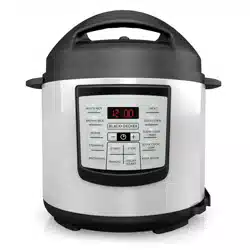Documents: Go to download!
- User Manual - (English)
- GETTING TO KNOW YOUR ELECTRIC PRESSURE COOKER
- CONTROL PANEL
- OPERATING INSTRUCTIONS
- PRESET COOKING FUNCTIONS
- CARE AND CLEANING
- HELPFUL HINTS AND TIPS
- TROUBLESHOOTING
Table of contents
Owner Manual PRESSURE COOKER
GETTING TO KNOW YOUR ELECTRIC PRESSURE COOKER
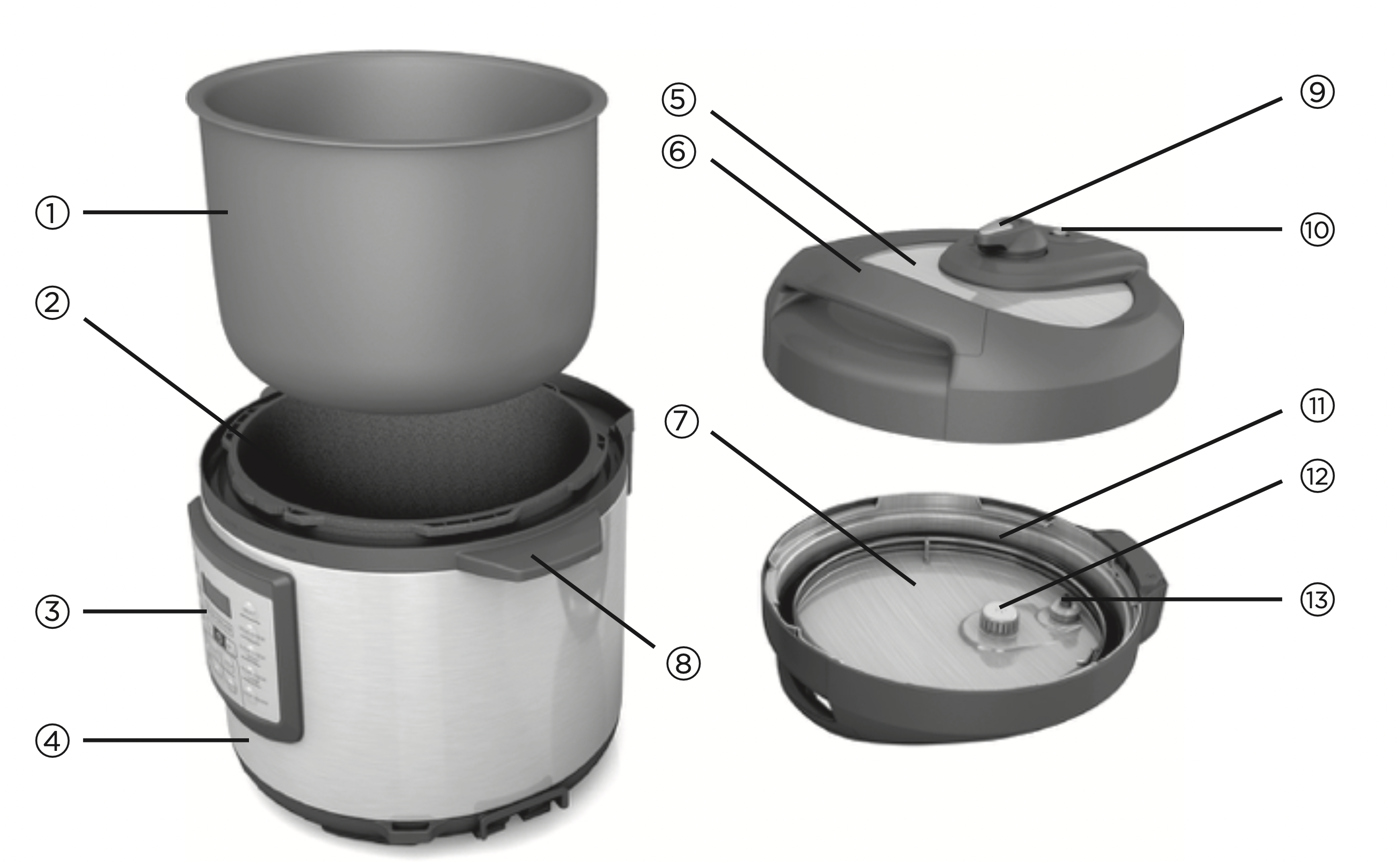
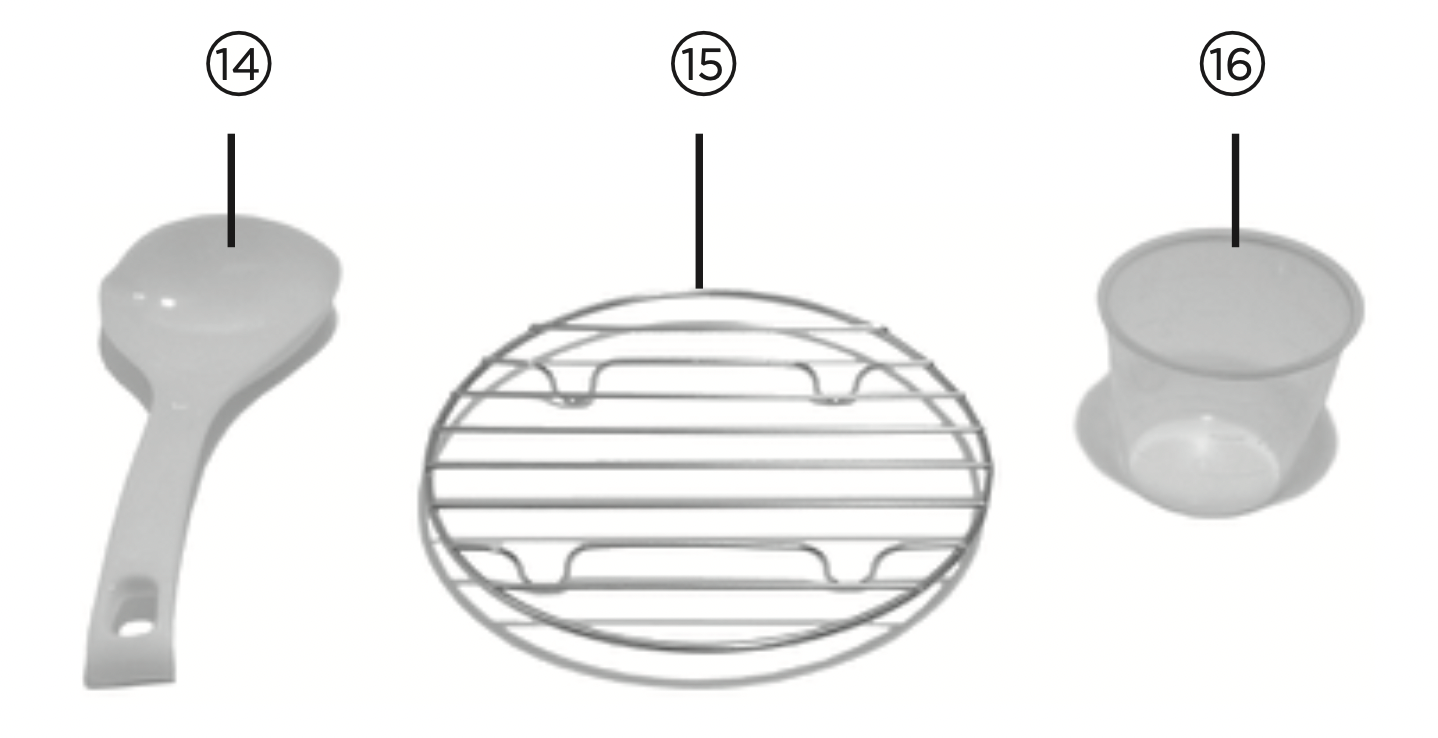
- Cooking bowl (Part # PR100-07)
- Interior
- Control panel
- Base
- Lid (Part # PR100-01)
- Lid Handle
- Inside of lid
- Base Handle
- Pressure Release Valve (Part # PR100-03)
- Red Float Valve (Part # PR100-02)
- Rubber Gasket (Part # PR100-04)
- Anti-block shield (Part # PR100-06)
- Rubber Float valve seal (Part # PR100-05)
- Rice scoop (Part # PR100-08)
- Trivet (Part # PR100-09)
- Rice measure (Part # PR100-10)
CONTROL PANEL
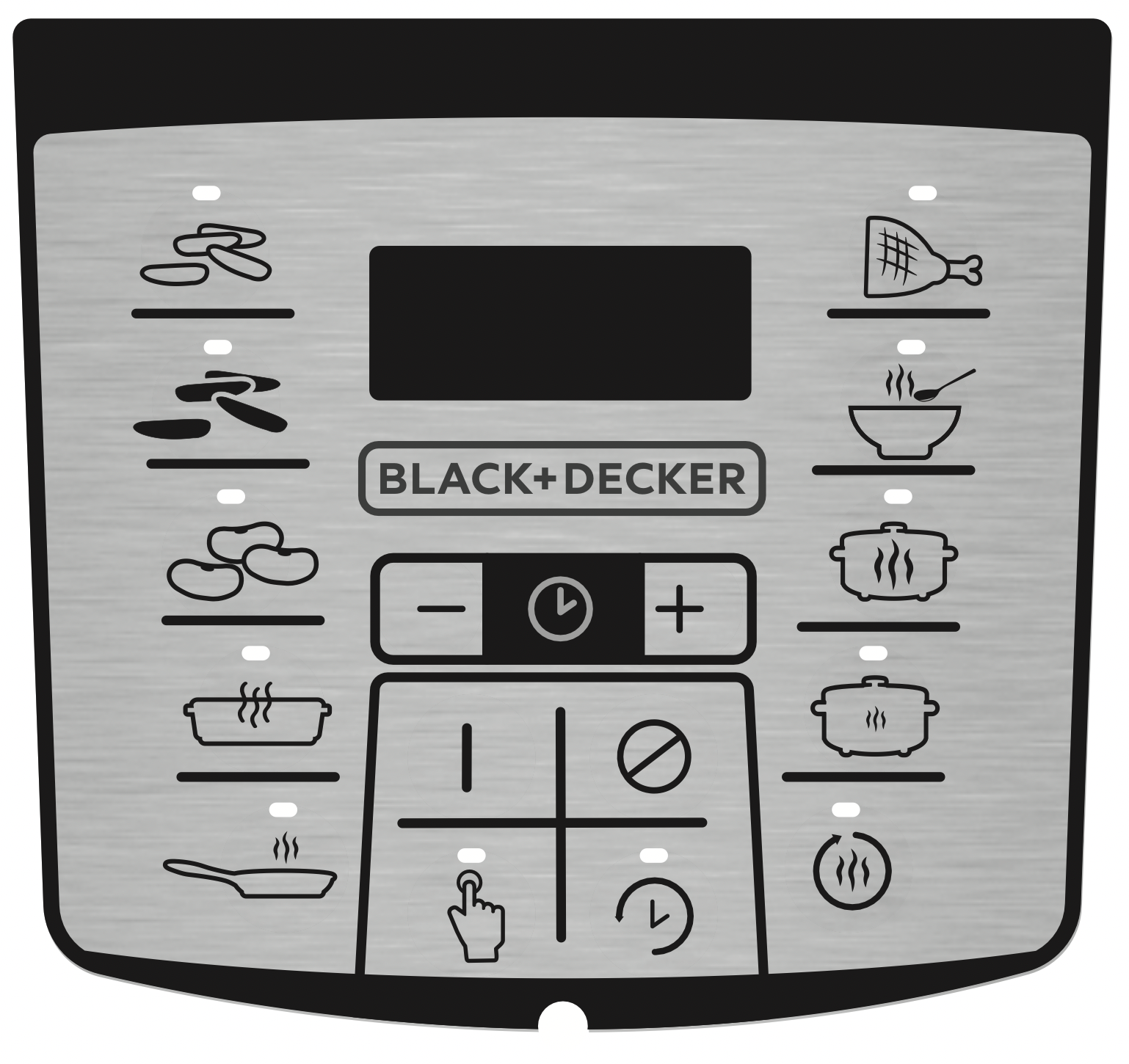
Model # PR100SD
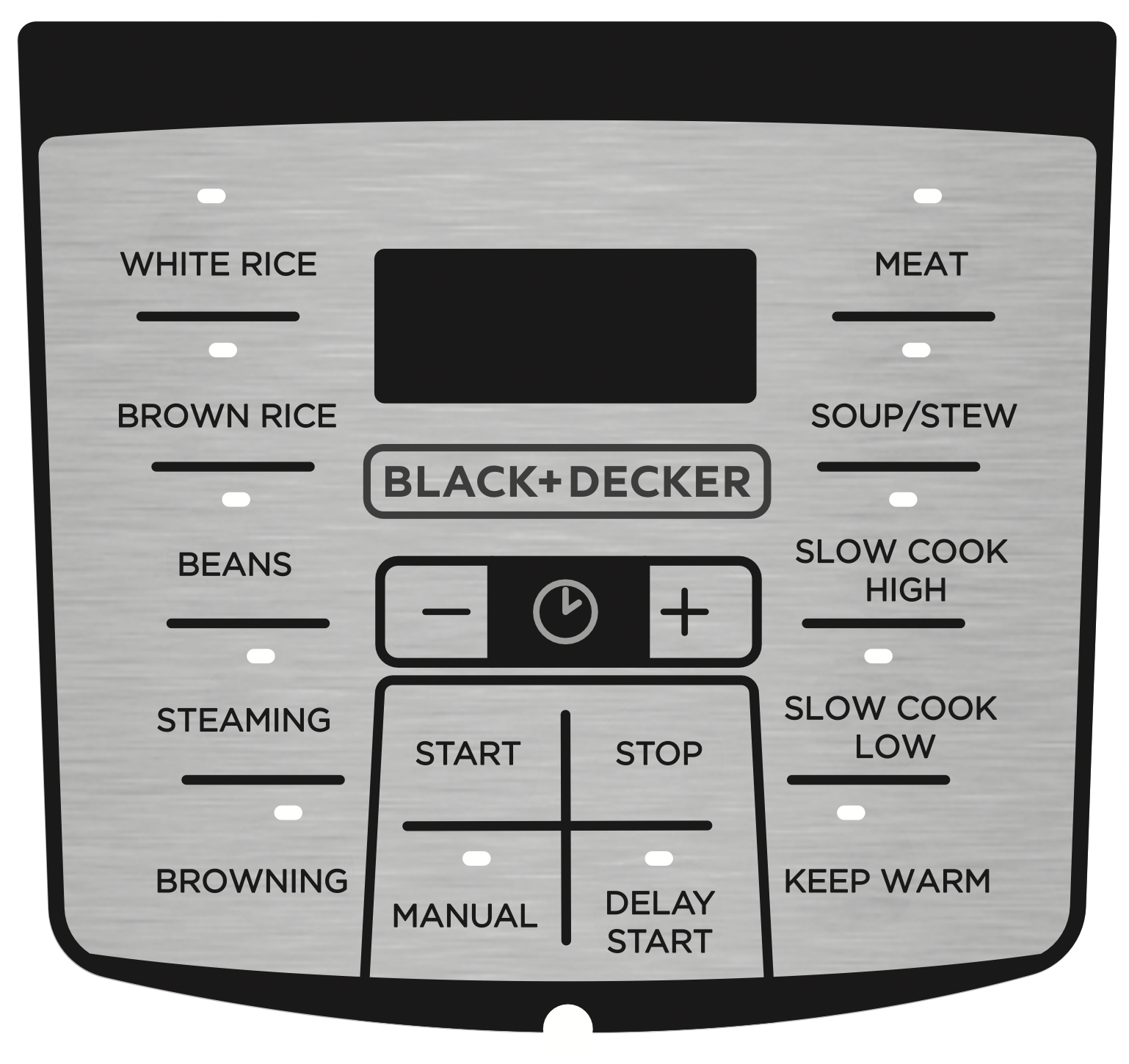
Model # PR100
OPERATING INSTRUCTIONS
Your BLACK+DECKER™ Electric Pressure Cooker has been specially designed to safely control the steam pressure and temperature during cooking. Below are instructions on how to properly assemble your pressure cooker to ensure optimal results.
Note: Place the pressure cooker on a dry, level surface. Because small amounts of steam will escape during the heating, and sometimes the cooking process, do not use the pressure cooker under overhanging cabinets.
- To open the lid: Hold the lid handle and turn the lid counter-clockwise until the “
 ” marking on the lid aligns with the “OPEN
” marking on the lid aligns with the “OPEN  ” marking on the pressure cooker; lift the lid straight up and off the pressure cooker. (A)
” marking on the pressure cooker; lift the lid straight up and off the pressure cooker. (A)
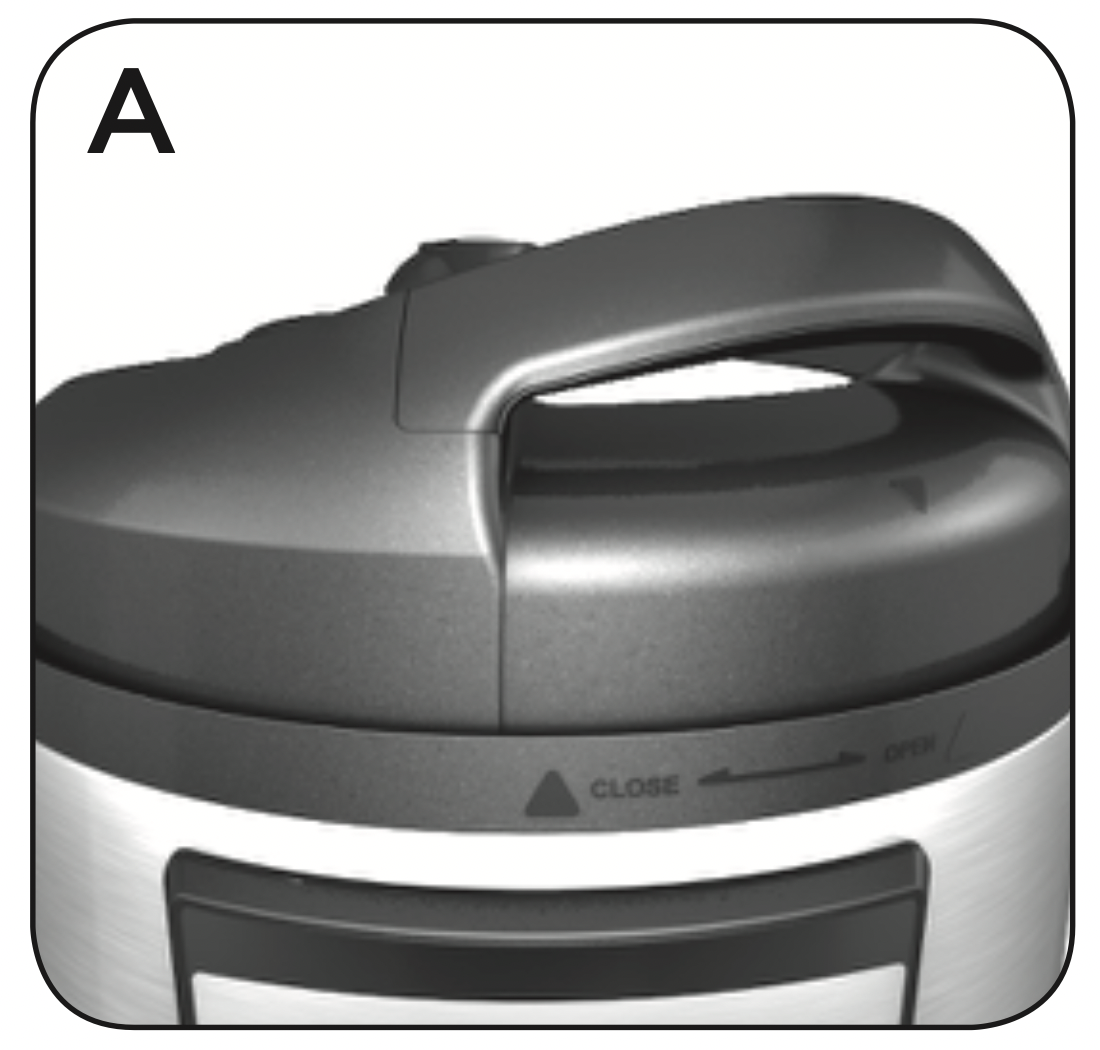
- Place the pressure release valve on the lid. (B) The valve will snap into place, but will fit loosely so steam escapes properly.
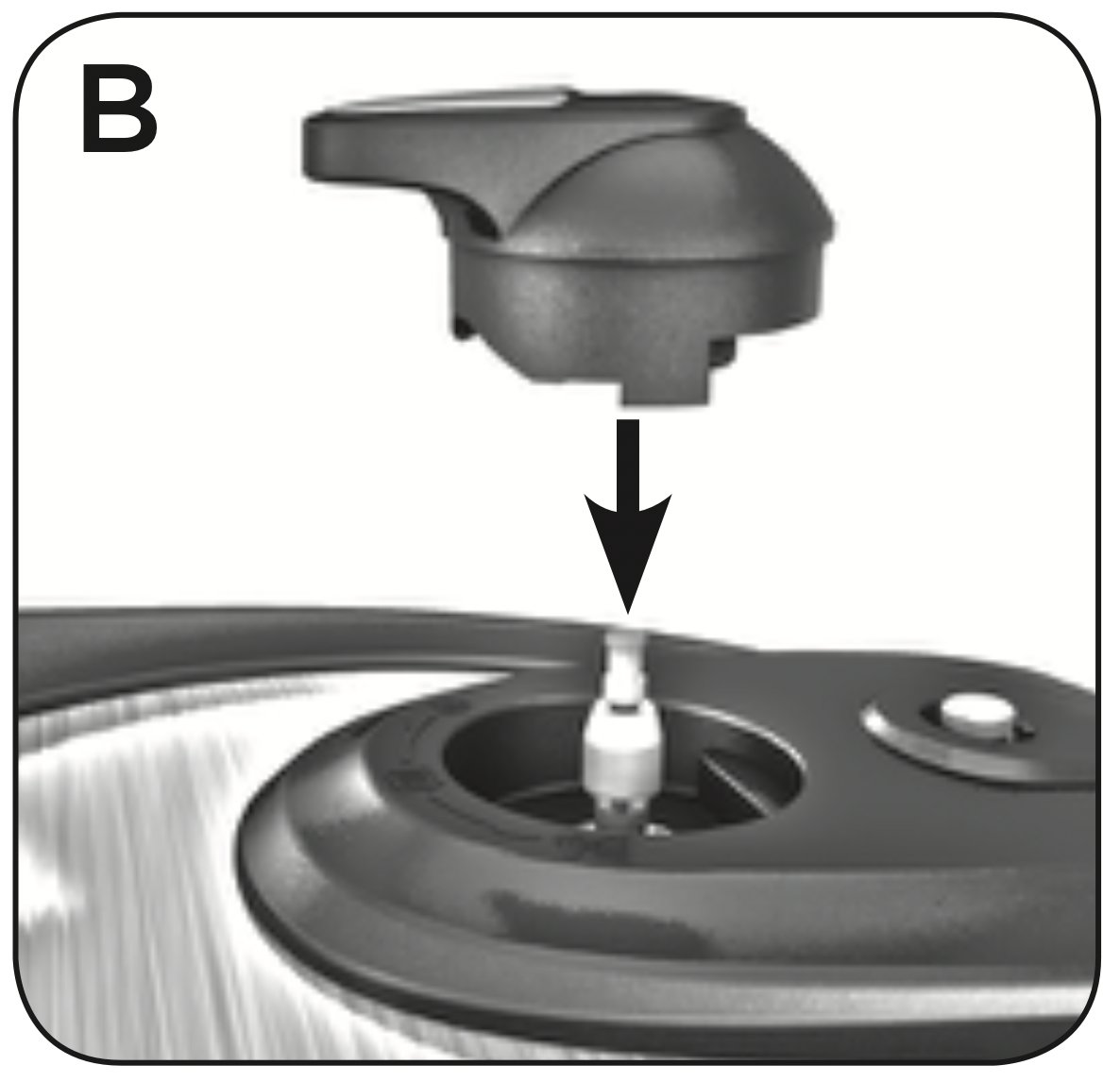
- Ensure that the rubber gasket is clean and securely fitted around the metal ring inside of the lid. (C)
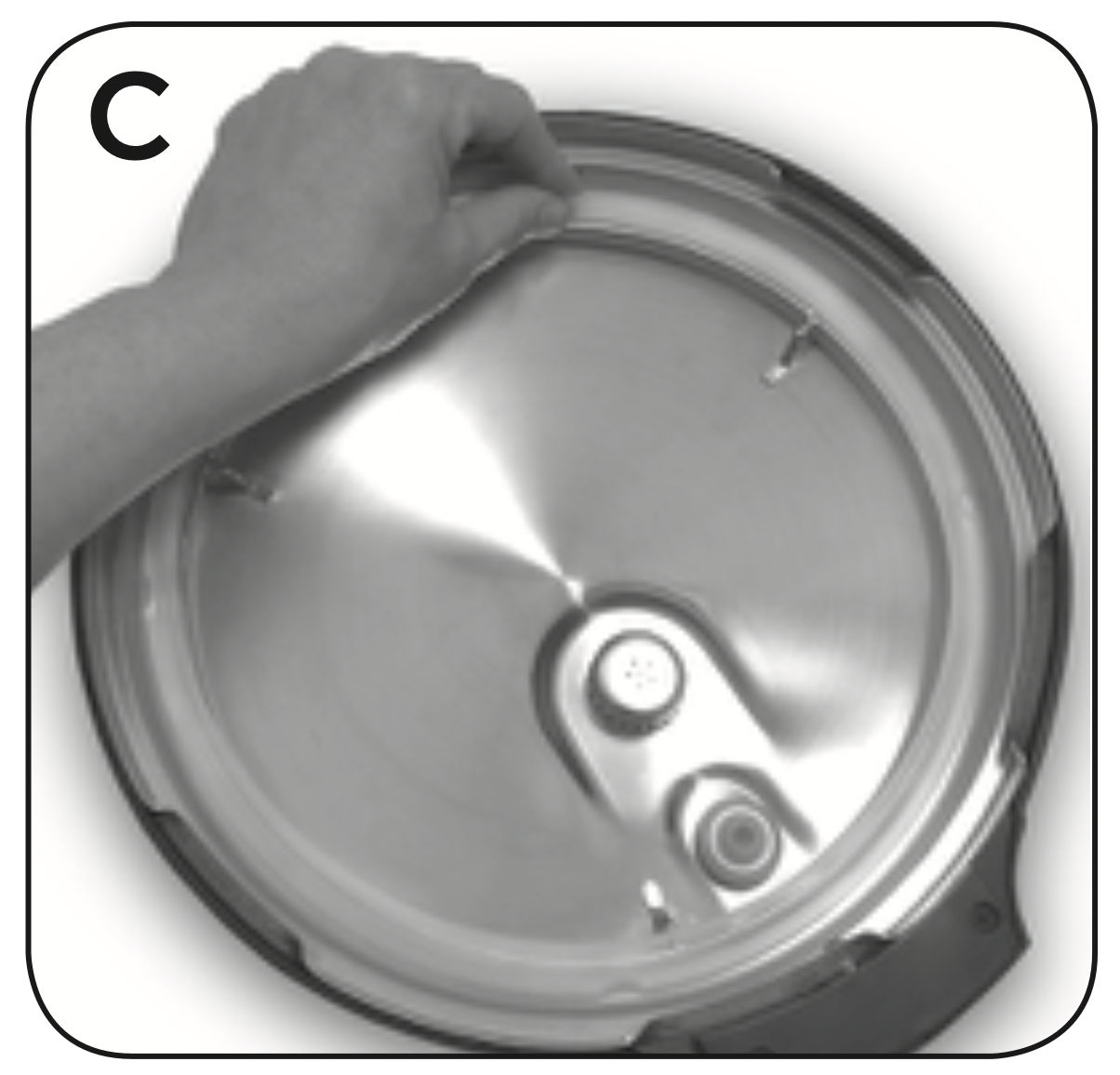
- Add foods and liquids to be cooked to the cooking bowl according to the recipe, and place in the interior of the pressure cooker.
See other models: TO3250XSB MX400B-T DLX1050B TO1785SG RC503
Note: Never fill the cooking bowl above the MAX fill line as it may clog the pressure release valve and cause excess pressure to build. When cooking foods such as dried beans, vegetables, rice and grains, do not fill the cooking bowl above the 5 cup line as these foods will expand during cooking. - To close the lid: Hold the lid handle and turn the lid clockwise until the “
 ” marking on the lid aligns with the “CLOSE
” marking on the lid aligns with the “CLOSE  ” marking on the pressure cooker. (D) The lid is now locked in place.
” marking on the pressure cooker. (D) The lid is now locked in place.
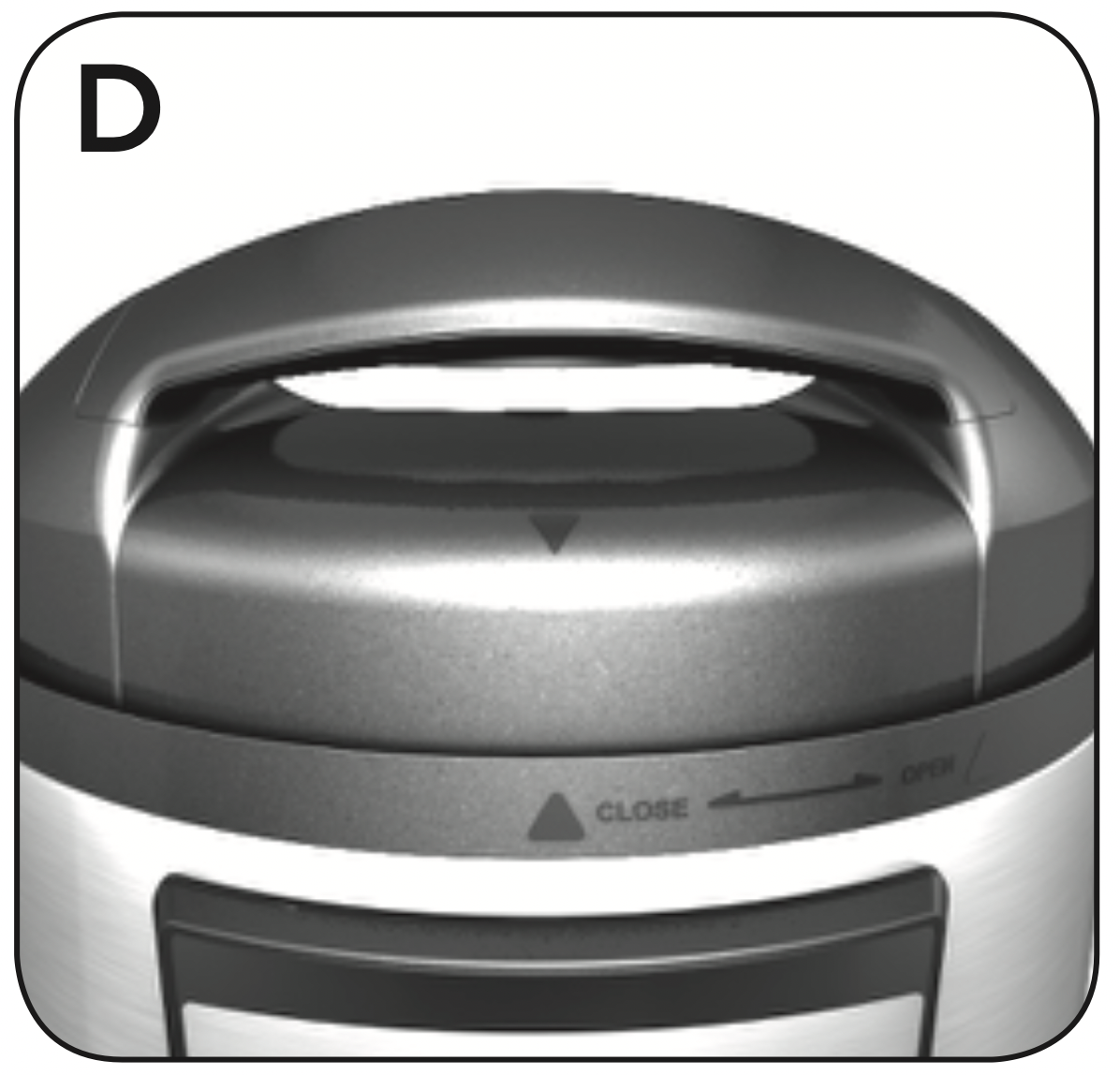
Note: If you press “Start” but the lid is not correctly closed, the main screen will blink “OPEN”. The unit will not heat on the pressure settings unless the lid is properly closed.
but the lid is not correctly closed, the main screen will blink “OPEN”. The unit will not heat on the pressure settings unless the lid is properly closed. - Center the pressure release valve above the seal position (
 ) on the lid. (E) The valve must be pointed down to properly seal the pressure cooker before cooking. If the pressure release valve has not been aligned properly, pressure will not build up and you may not achieve desired results.
) on the lid. (E) The valve must be pointed down to properly seal the pressure cooker before cooking. If the pressure release valve has not been aligned properly, pressure will not build up and you may not achieve desired results.
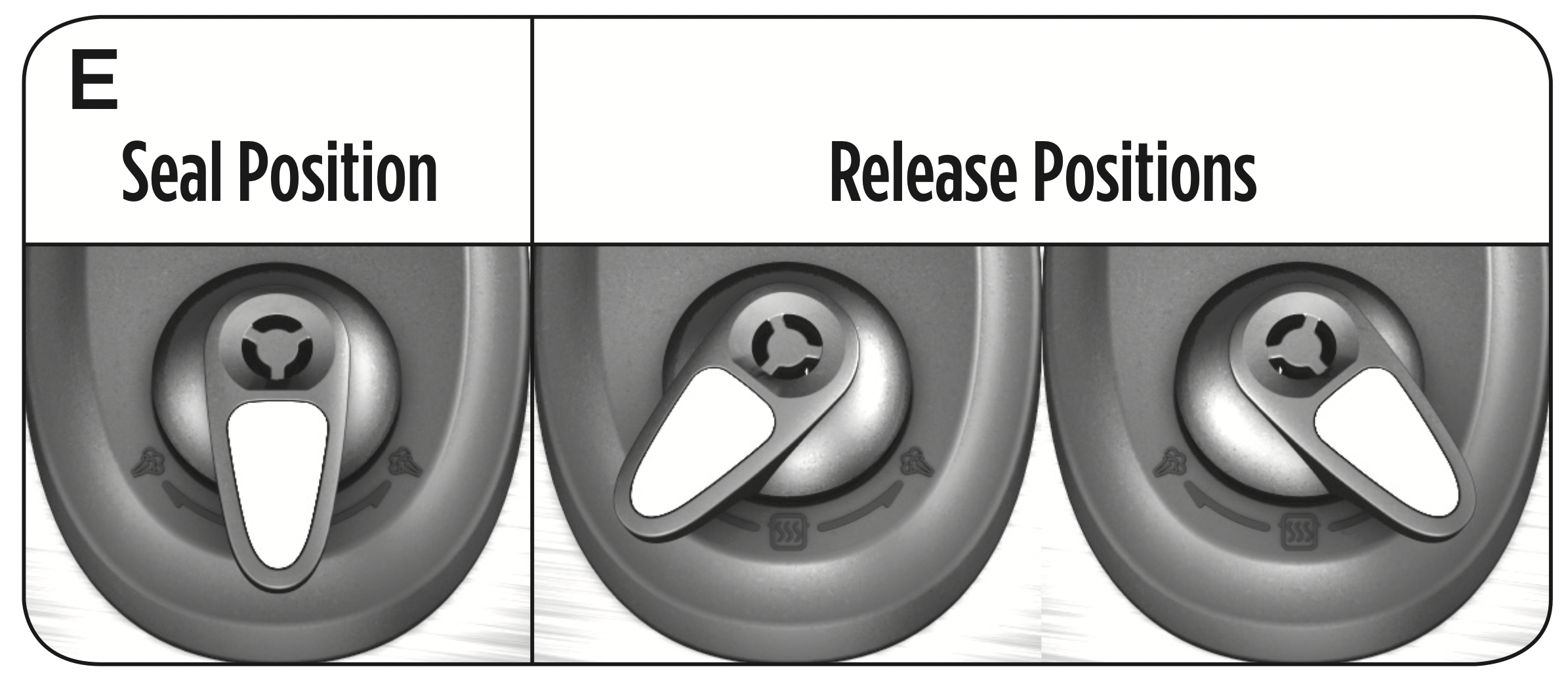
- Plug in the pressure cooker to a wall outlet. The LED display will flash ----. Once a function is selected (see “Preset Cooking Functions”) a red light will flash above the selected function and a default time will appear on the LED display. If the time needs to be adjusted, press the + or buttons to select the correct time. Then press the START
 button.
button.
Note: If you already know the proper cook times, the manual function allows you to easily choose any time based on your cooking needs. The timer will automatically default to 30 min but can be adjusted using the instructions above. For general cook time guidelines, see the preset function section for information.
allows you to easily choose any time based on your cooking needs. The timer will automatically default to 30 min but can be adjusted using the instructions above. For general cook time guidelines, see the preset function section for information. - Once the START
 button has been pressed, the red light above the selected function will turn solid and the pressure cooker will begin to build pressure. The amount of time to build pressure will depend on the amount of liquid and food inside the cooking bowl.
button has been pressed, the red light above the selected function will turn solid and the pressure cooker will begin to build pressure. The amount of time to build pressure will depend on the amount of liquid and food inside the cooking bowl. - As pressure builds, the LED display will show building dashes that will blink until the desired pressure has been reached (F). Once up to pressure, the pressure cooker will beep and the timer will start. This is also indicated by the red float valve in the elevated position. (G)
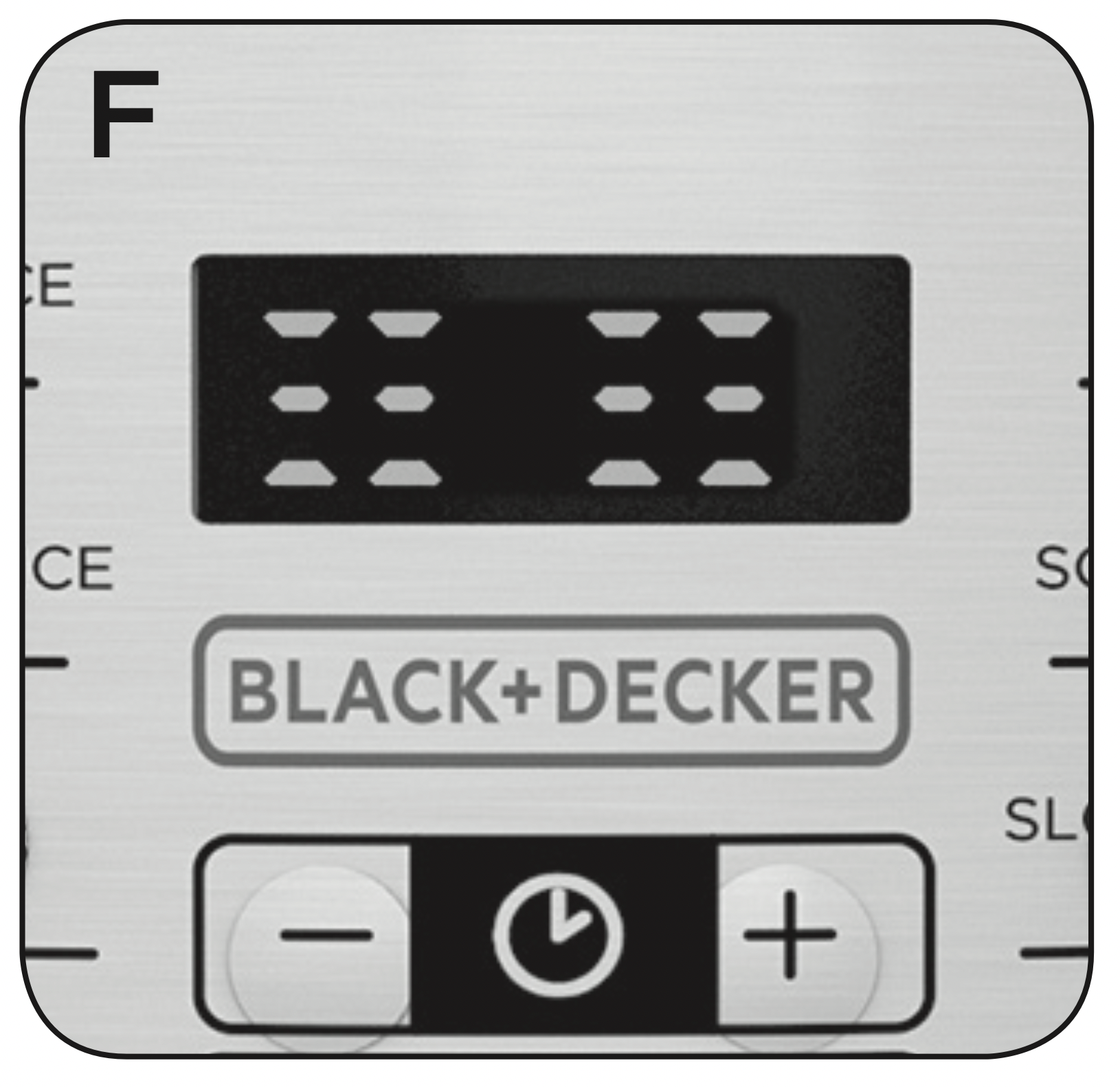
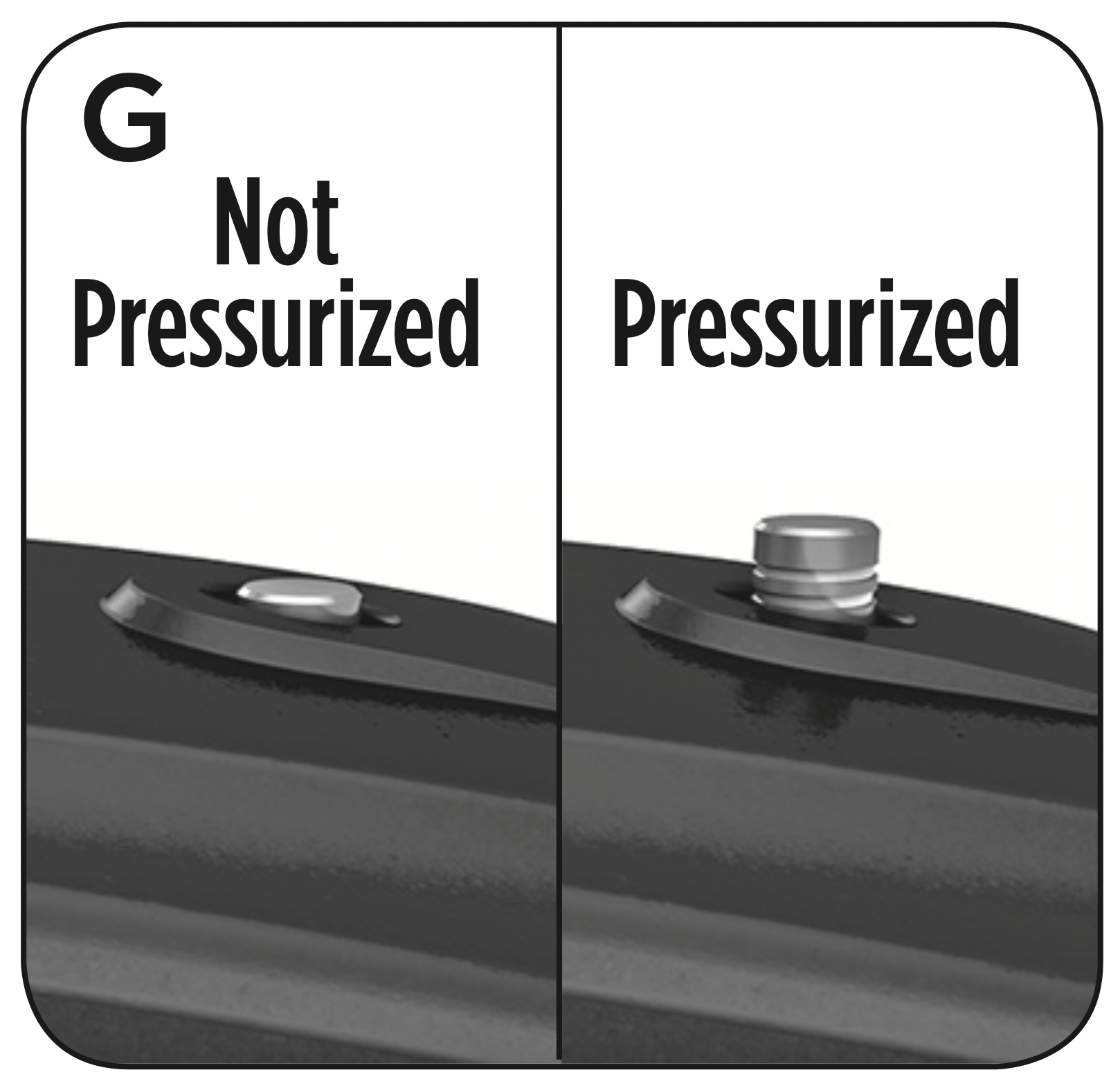
Note: Never attempt to open the lid while pressure cooking. If you must open the lid while pressure cooking, press the STOP button (H) and, using a kitchen utensil, push the pressure release valve to the right or the left to allow steam to escape. (I) Once all steam is released, the pressure cooker is safe to open.
(H) and, using a kitchen utensil, push the pressure release valve to the right or the left to allow steam to escape. (I) Once all steam is released, the pressure cooker is safe to open.
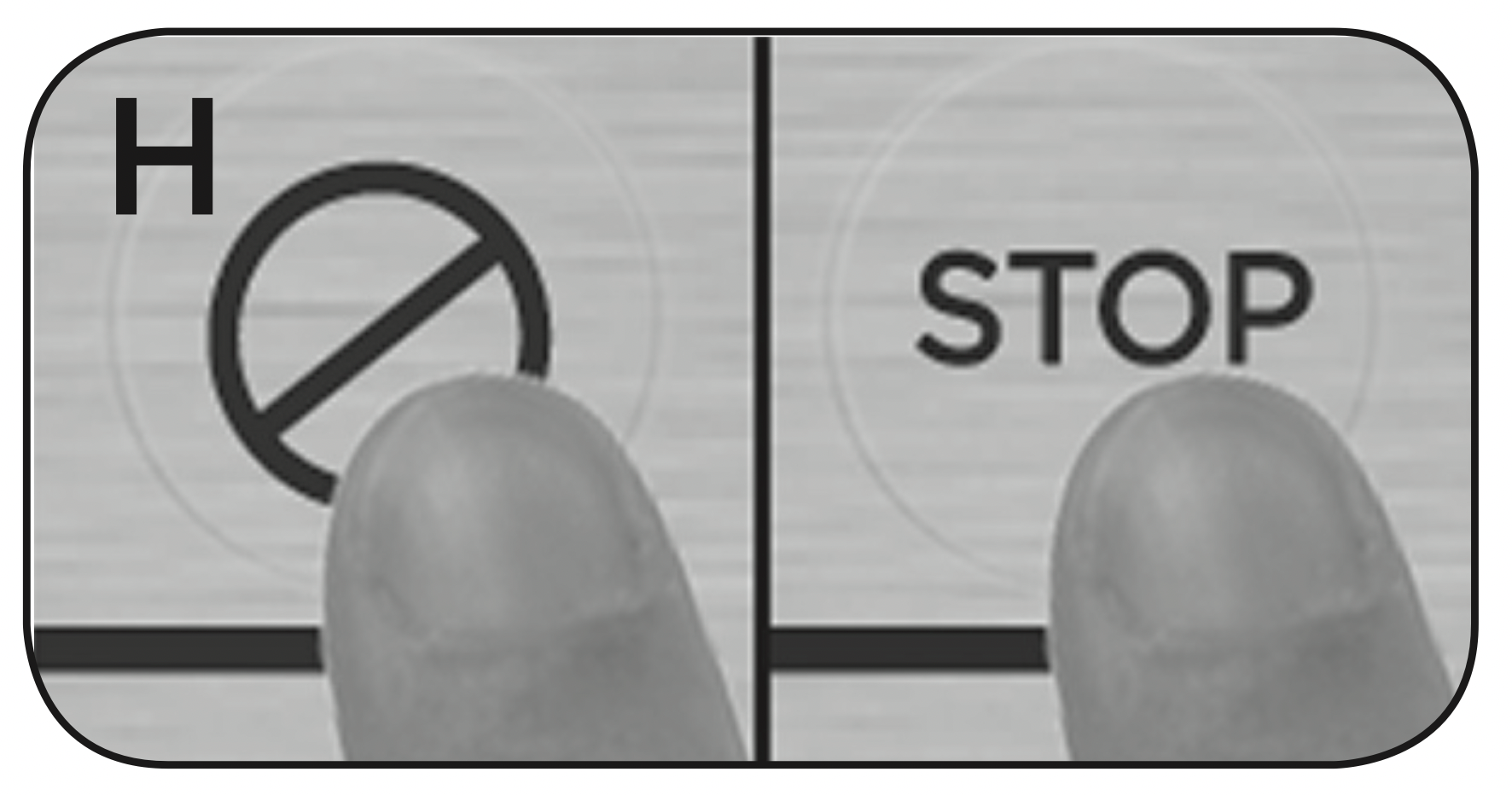

- When time has ended, the pressure cooker will beep and will automatically switch to Keep Warm. A solid red light will illuminate above the Keep Warm button
 and the timer will flash and begin to count up. At this time you can choose either Natural Pressure Release or Quick Pressure Release:
and the timer will flash and begin to count up. At this time you can choose either Natural Pressure Release or Quick Pressure Release:
Natural Pressure Release: after the cook time is complete, the pressure will begin to drop. During this time food will continue to cook, which is recommended for some cuts of meats and beans. See preset cooking function section for tips on recommended cooking methods. At any time during the natural release process, you can switch methods to the Quick release option.
Note: The amount of time for the pressure to drop depends on the amount of food/liquid inside the cooking bowl.
Quick Pressure Release: after cook time is complete, use tongs or a kitchen utensil to move the pressure release valve to the right or left, to release the pressure. Steam will instantly release from the valve. Keep face and hands away as steam is released. Quick pressure release immediately stops the cooking process. If additional cooking is needed, choose the necessary function to bring cooker back up to pressure.
Note: The steam is fully released when the red float valve is in the lower position (J), only then will the lid be safe to open.
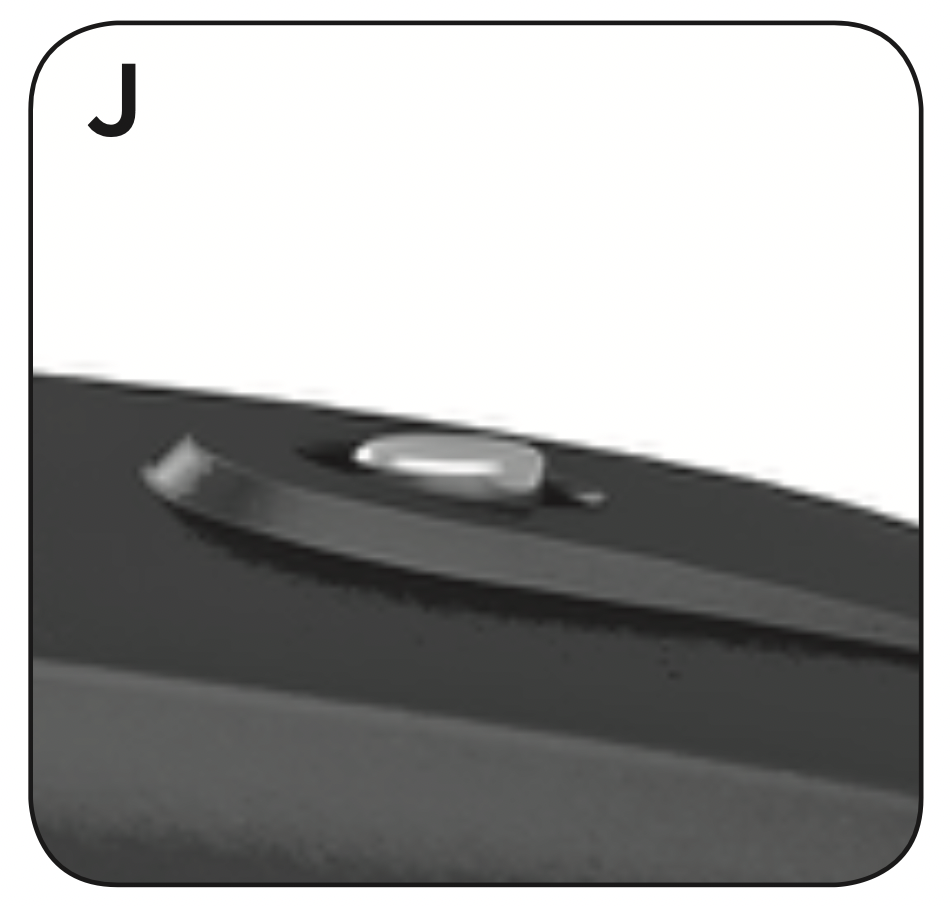
- To open the lid: Hold the lid handle and turn the lid counter-clockwise until the “
 ” marking on the lid aligns with the “OPEN
” marking on the lid aligns with the “OPEN  ” marking on the pressure cooker; lift the lid straight up and off the pressure cooker.
” marking on the pressure cooker; lift the lid straight up and off the pressure cooker.
Note: Steam will escape when opening the lid, even after release. Always lift the lid straight off and use caution when opening. - Always allow the pressure cooker to fully cool before cleaning and storage.
PRESET COOKING FUNCTIONS
There are 11 preset functions to aid in making the cooking process as easy as possible. Below are approximate cooking times to use as general guidelines. Times will vary depending on amounts of food cooked.
Note: the below cooking times do not include the time it takes for the pressure cooker to build up to pressure.
FUNCTIONS WITH PRESSURE:
WHITE RICE  :
:
- Measure out the desired amount of rice or grains with the provided measure cup and add to the cooking bowl. Then add the corresponding amount of water indicated in the chart.
- Add 1–2 tablespoons of butter or oil to the rice to minimize frothing.
Note: Do not fill the cooking bowl more than half full, as the rice will expand during cooking. - If the bowl is not already in the cooking base, add the bowl to the base and follow the cooking process outlined in the “Operating Instructions” section.
- Use the Natural Pressure Release method for best results. If making sticky rice, use the Quick Pressure Release method.

BROWN RICE  :
:
- Measure out the desired amount of rice with the provided measure cup, add to the cooking bowl. Then add the corresponding amount of water indicated in the chart below.
- Add 1–2 tablespoons of butter or oil to the rice to minimize frothing.
Note: Do not fill the cooking bowl more than half full, as the rice will expand during cooking. - If the bowl is not already in the cooking base, add the bowl to the base and follow the cooking process outlined in the “Operating Instructions” section.
- Use the Natural Pressure Release method for best results.
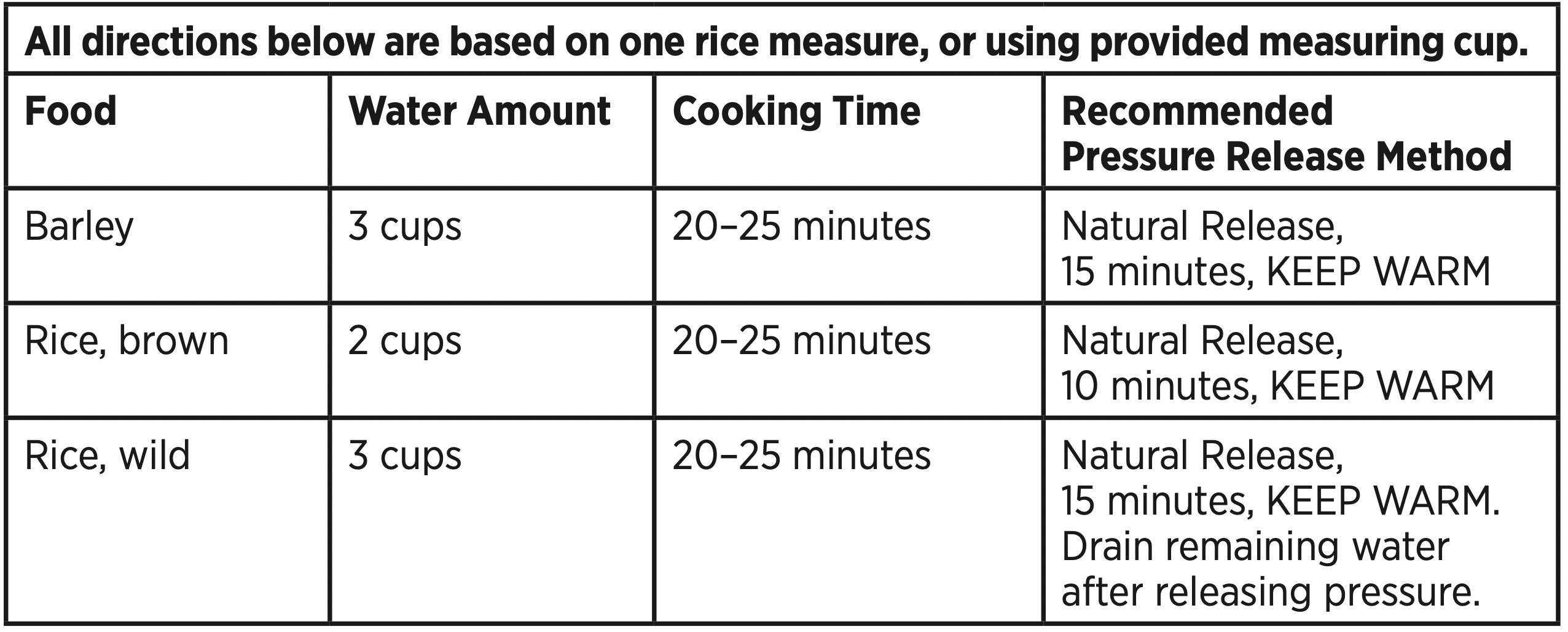
BEANS  :
:
- Sort beans and remove any pebbles or bad looking beans. Rinse dried beans under cold water and drain. Add the beans to the cooking bowl.
Note: You do not need to soak beans before pressure cooking. The cooking chart displays both unsoaked and soaked cook times. - Add 1–2 tablespoons of butter or oil to the beans to minimize frothing.
Note: Do not fill the cooking bowl more than half full, as the beans will expand during cooking. Always use enough liquid to cover the beans. - If the bowl is not already in the cooking base, add the bowl to the base and follow the cooking process outlined in the “Operating Instructions” section.
- Use the Natural Pressure Release method for best results.
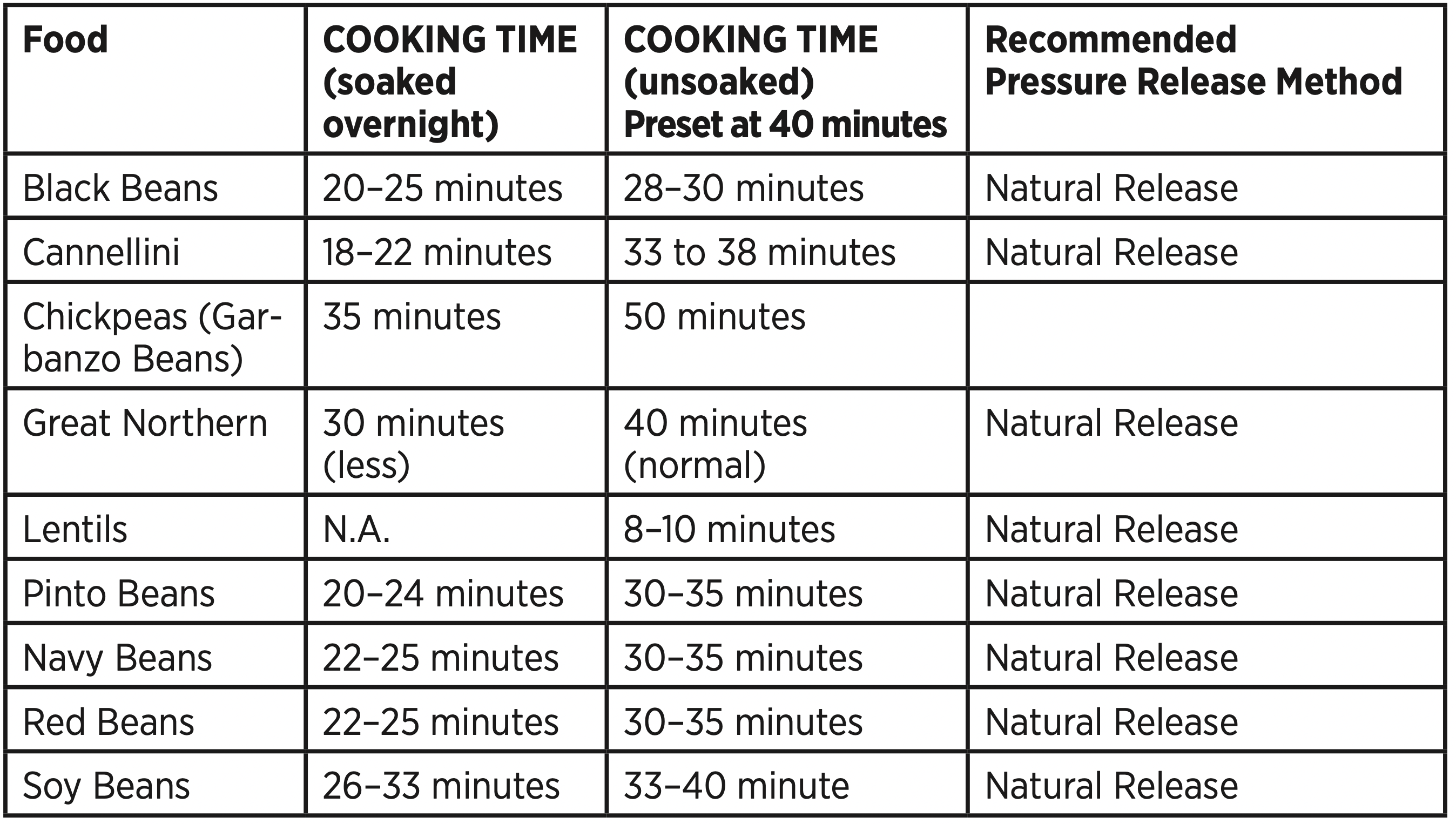
STEAMING  :
:
- While steaming use the provided trivet for more evenly cooked results.
Place the trivet in the bottom of the cooking bowl before adding the ingredients. - Add approximately 1 cup of liquid to the cooking bowl while steaming vegetables.
- If the bowl is not already in the cooking base, add the bowl to the base and follow the cooking process outlined in the “Operating Instructions” section.
- Use the Quick Pressure Release method when pressure cooking vegetables, to prevent over cooking.
Note: If cooking frozen vegetables, allow an additional 1–2 minutes of cooking time.
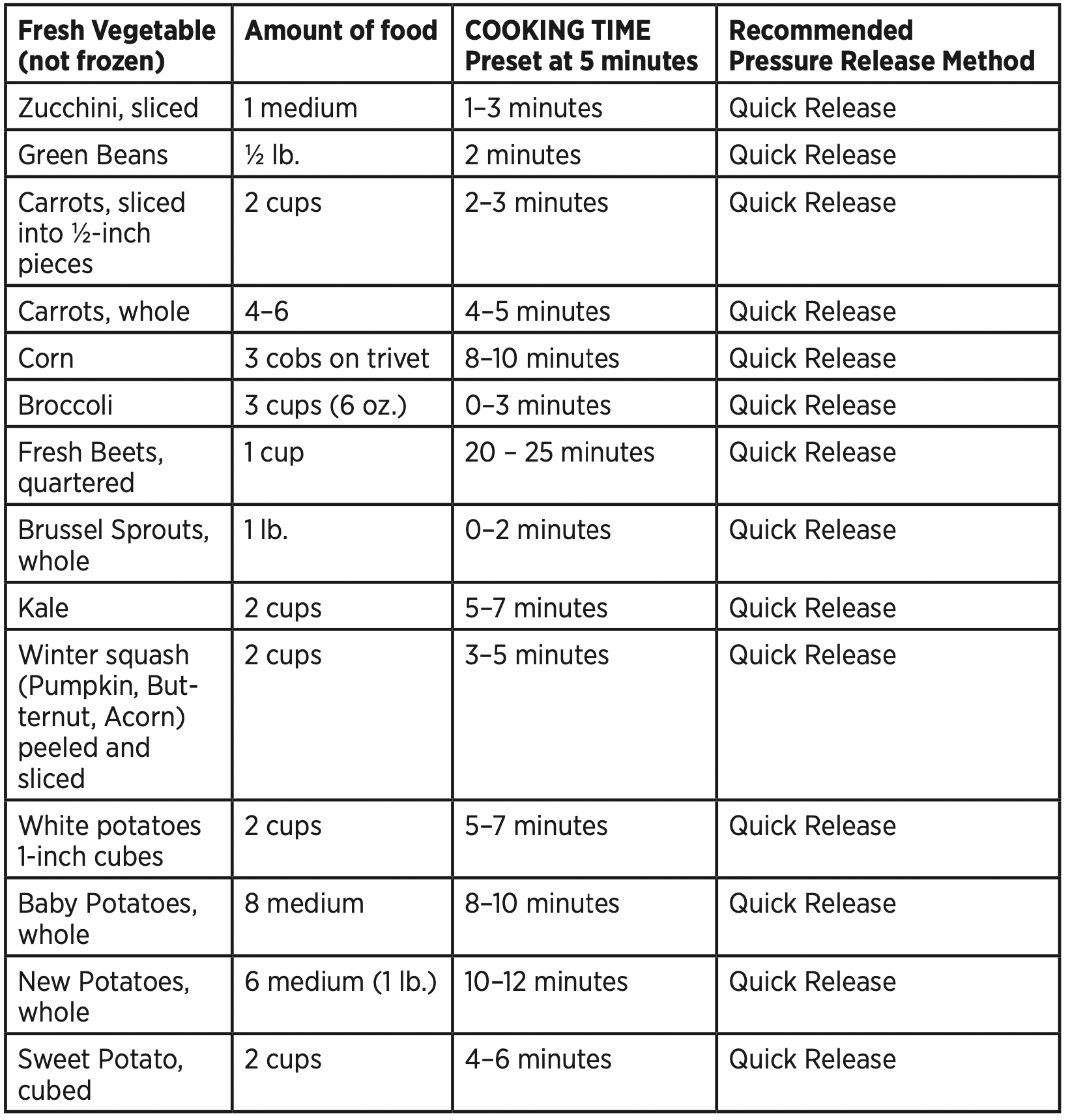
MEAT  :
:
- Cut meats/poultry into equal sizes to ensure even cooking.
Tip: Brown the meats before pressure cooking using the Browning preset function within this section.
within this section. - Add liquids and other ingredients to the bowl according to the recipe along with meat.
- If the bowl is not already in the cooking base, add the bowl to the base and follow the cooking process outlined in the “Operating Instructions” section.
- Use the release method indicated in the cooking chart for best results.
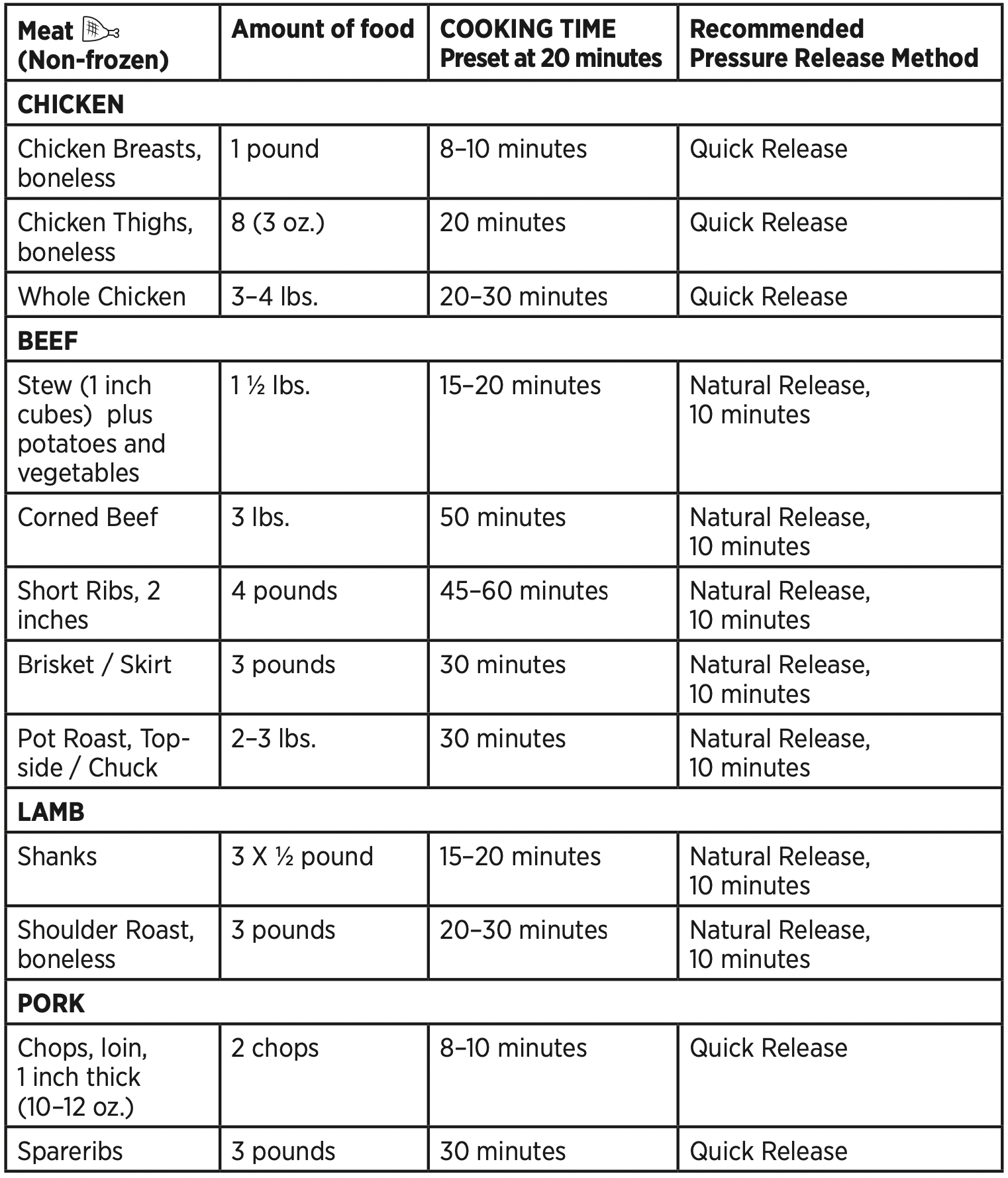

SOUP/STEW  :
:
Note: The preset time for this function is 30 minutes, but can be adjusted up and down to desired cook time.
- Place all the prepared ingredients into the pressure cooking bowl, being sure not to fill beyond the MAX fill line.
- If the bowl is not already in the cooking base, add the bowl to the base and follow the cooking process outlined in the “Operating Instructions” section.
- Use the natural release method to decrease any spatter from the steam release value and continue cooking the foods for a deeper flavor.
MANUAL COOKING FUNCTIONS 
The Manual pressure function can be used when preset menu functions and timings do not suit your required cooking preferences. Follow the steps outlined in the “Operating Instructions” section to use this function.
FUNCTIONS WITHOUT PRESSURE
BROWNING  :
:
This is not a pressurized setting and it is intended to be used without the lid in place. Use this function to brown or sauté meats and vegetables at a high heat before pressure cooking or slow cooking.
- Place the cooking bowl in the interior of the pressure cooker.
- Add the proper amount of oil or butter to the bowl, according to the recipe.
- Press the Browning button
 . A red light will begin flashing above the Browning function
. A red light will begin flashing above the Browning function  , and the LED display will flash with 15 minute default. Press the + or – buttons to adjust the time.
, and the LED display will flash with 15 minute default. Press the + or – buttons to adjust the time.
Note: The locking lid should remain off while browning. - Press the START button and allow the butter or oil to heat for about 1 minute. Add the food using caution once the oil or butter is hot, as it could spatter, and then brown/sauté to desired doneness.
Note: Pat foods dry with a paper towel before browning and brown/sauté food in small batches to ensure best results.
and brown/sauté food in small batches to ensure best results. - Once you are done browning/sautéing, press the STOP button
 to cancel the Browning function. You can now switch to any other function to continue cooking the recipe (refer to the specific function within this section for directions).
to cancel the Browning function. You can now switch to any other function to continue cooking the recipe (refer to the specific function within this section for directions).
SLOW COOK  :
:
This is not a pressurized setting, but is intended to be used with the lid in place. When slow cooking, it is extremely important that you do not often open the lid to check on the cooking progress. Each time the lid is opened, your cook time will need to be increased.
- Place the cooking bowl in the interior of the pressure cooker.
- Place all necessary ingredients into the cooking bowl. Do not fill above the MAX fill line.
- Place the lid on the pressure cooker and rotate clockwise to align the “ ” marking on the lid with the “CLOSE ” marking on the pressure cooker. The pressure release valve should be left in the release position (K) during slow cooking.
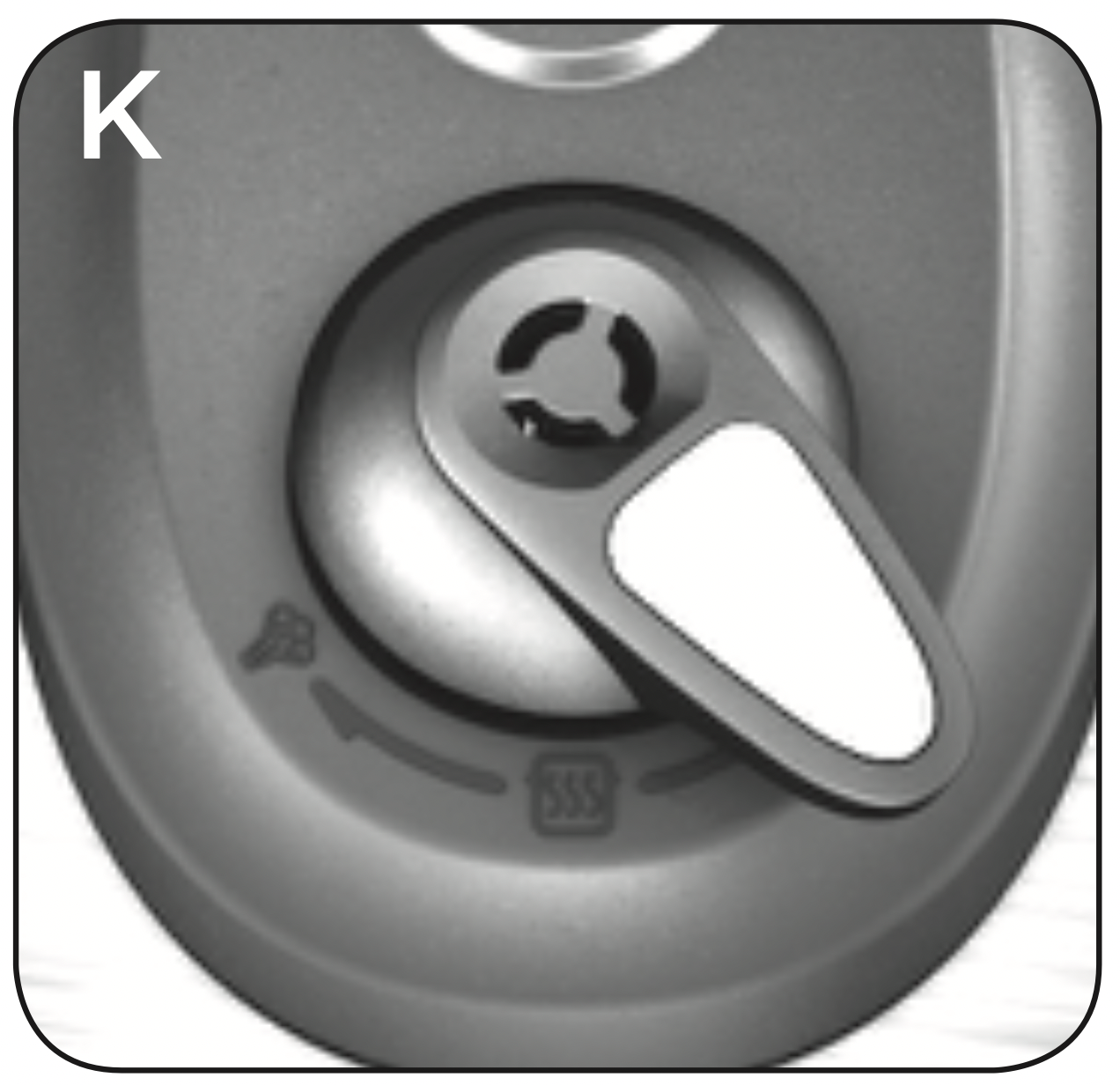
- Press either the Slow Cook High
 or the Slow Cook Low
or the Slow Cook Low  button. A red light will begin flashing above the selected function, and the LED display will flash with 6 hour default for HIGH and an 8 hour default for LOW. Press the + or – buttons to adjust the time.
button. A red light will begin flashing above the selected function, and the LED display will flash with 6 hour default for HIGH and an 8 hour default for LOW. Press the + or – buttons to adjust the time. - Press the START button
 . The red light will turn solid above the chosen function and the timer will begin to countdown.
. The red light will turn solid above the chosen function and the timer will begin to countdown. - Once the time is up, the pressure cooker will automatically switch to keep warm. A flashing red light will illuminate above the Keep Warm button
 and the timer will flash and begin to count up.
and the timer will flash and begin to count up. - To open the lid: Hold the lid handle and turn the lid counter-clockwise until the “
 ” marking on the lid aligns with the “OPEN
” marking on the lid aligns with the “OPEN  ” marking on the pressure cooker; lift the lid straight up and off the pressure cooker.
” marking on the pressure cooker; lift the lid straight up and off the pressure cooker.
Note: Steam may escape when opening the lid. Always lift the lid straight off and use caution when opening. - Always allow the pressure cooker to fully cool before cleaning and storage.
Note: Do not cut meats in the cooking bowl as this may scratch the finish.
DELAY START  :
:
The delay start feature is ideal for planning out meals on your schedule, allowing you to delay cooking for a set amount of time. This feature works for all functions except browning, slow cook, and keep warm. Always be sure to follow food safety recommendations while cooking.
- Once a function is selected (see “Preset Cooking Functions”) a red light will flash above the selected function and a default time will appear on the LED display. If the time needs to be adjusted, press the + or buttons to select the correct time.
- Press the delay start button
 , a red light will flash above the function and a default time will appear on the LED display. First adjust the hours as needed by pressing the + or – buttons (adjusts in 1 hour increments), then press delay start
, a red light will flash above the function and a default time will appear on the LED display. First adjust the hours as needed by pressing the + or – buttons (adjusts in 1 hour increments), then press delay start  again to adjust the minutes by pressing the + or – buttons (adjusts in 10 minute increments).
again to adjust the minutes by pressing the + or – buttons (adjusts in 10 minute increments). - Once adjusted to desired delay start time, then press the Start button
 and follow the standard instructions.
and follow the standard instructions.
CARE AND CLEANING
This product contains no user serviceable parts. Refer service to qualified service personnel.
CLEANING
IMPORTANT: Never immerse cooking base in water or other liquids.
- Always unplug and allow to completely cool before cleaning.
- Wash cooking bowl and lid in warm, soapy water. If food sticks to the cooking bowl fill the bowl with warm, soapy water and allow it to soak before cleaning with plastic scouring pad.
NOTE: the cooking bowl is dishwasher safe. - Rinse and dry thoroughly.
- Wipe interior and exterior of the cooking base with a soft, slightly damp cloth or sponge. Never use abrasive cleaners or scouring pads to clean the cooking base, as they may damage the surfaces.
- Remove the gasket, anti block shield and pressure release valve from lid and wash in warm soapy water. Allow parts to dry completely before reassembling.
STORING
Make sure that the appliance is thoroughly dry. Never wrap the cord tightly around the appliance; keep it loosely coiled.
HELPFUL HINTS AND TIPS
- Always make sure the pressure release valve is in the “seal” position, otherwise pressure will not build and your meal will take much longer to cook.
- If using any sort of carbonated beverage to cook with, always use Natural Pressure Release until the pressure release valve no longer releases steam. This will ensure the carbonation has time to dissipate and not boil over the pressure cooker.
- Do not cook pasta on its own in the pressure cooker. It’s very likely it will stick together and turn out like a brick of pasta.
- Have a favorite slow cooker recipe? The pressure cooker is a perfect way to turn a 4–6 hour recipe into one that’s done in about an hour (depending on amount of food/liquid).
- Forgot to put all of your ingredients in the slow cooker in the morning? No problem! Place all of those ingredients in the pressure cooker and create a delicious meal just in time for dinner.
- The Browning function
 is a great way to brown meats and veggies in one pot before cooking the rest of your meal. Use a small amount of oil (1–2 Tbsp.) and sauté meats or veggies for added flavor.
is a great way to brown meats and veggies in one pot before cooking the rest of your meal. Use a small amount of oil (1–2 Tbsp.) and sauté meats or veggies for added flavor. - If cooking cuts of meat on their own, always make sure to allow a “rest” period by taking the meat out of the pressure cooker. Place it on a cutting board to rest for 5–10 minutes before cutting. This allows the meat to redistribute and retain its delicious juices.
- Make sure that meat and vegetables are of uniform size when cooking in the pressure cooker. This will allow for more even cooking.
- Liquid evaporates while in the pressure cooker, so always make sure there’s enough liquid in the pressure cooker to ensure food does not burn or get stuck to the bottom of the pressure cooker.
- Do not overfill the pot with liquid or food. Because the pressure cooker uses steam to cook, it needs space to build up and circulate.
- Most vegetables cook very quickly on the steaming function
 ; follow the chart in the steaming section to make sure they’re not overcooked and mushy.
; follow the chart in the steaming section to make sure they’re not overcooked and mushy. - Add any thickeners (such as flour or corn starch) after pressure cooking has finished. It takes your meal longer to cook when they are added at the beginning.
- Use the browning function
 at the end of cooking a sauce to thicken it.
at the end of cooking a sauce to thicken it.
TROUBLESHOOTING
|
PROBLEM |
POSSIBLE CAUSE |
SOLUTION |
||
| Difficult to close the lid | Rubber gasket not installed properly |
Check the position of the rubber gasket |
||
| Red float valve in the popped-up position |
Press the red float valve downward lightly |
|||
| Difficult to open the lid | Pressure exists inside the cooker |
Use the pressure release valve to reduce the internal pressure. Open the lid after the pressure is completely released |
||
| Red float valve stuck at the popped-up position |
Press the red float valve lightly downward with a kitchen utensil |
|||
| Steam leaks from the side of the lid | Rubber gasket not in place |
Install the rubber gasket correctly |
||
| Rubber gasket damaged |
Replace the rubber gasket |
|||
| Food debris attached to the rubber gasket |
Clean the rubber gasket |
|||
| Lid not closed properly |
Open then close the lid again |
|||
| Red float valve unable to rise |
Not enough food or water in the cooking bowl |
Add water according to the recipe |
||
| Red float valve is obstructed by the locking lid pin |
Close the lid completely, see “Operating Instructions” section |
|||
| Steam comes out from the exhaust valve without stopping | Lid is not in the seal position |
Turn the pressure release valve to the seal position |
||
| Pressure control fails |
Contact the consumer service team |
|||
| Display flashes “OPEN” | Lid is not at the correct position for the selected program |
Close the lid for pressuring cooking or open the lid for browning |
||
|
Display flashes 3 blinking bars but timer doesn’t start |
Working pressure isn’t reached inside during preheating cycle |
Pressure release valve is not in the seal position |
Check if pressure release value is turned to the seal position |
|
|
Rubber gasket is not in place |
Install the rubber gasket correctly |
|||
|
Red interlock pin with rubber retainer ring on bottom of lid is not in place |
Check that red interlock pin is installed with the rubber retainerring on the bottom of lid |
|||
|
Display flashes “C5” and the pressure cooker shuts down |
Overheating is detected on the cooking bowl |
Stop the program, use the pressure release valve to reduce the internal pressure and check if the food at the bottom of the cooking bowl is burnt |
||
|
Display remains blank after connecting the powercord |
Bad power connection or no power |
Inspect the power cord to ensure a good connection, check that the power outlet is active |
||
|
Appliance electrical issue |
Contact the consumer service team |
|||
|
All LEDs flash with a code appearing on screen |
C1code |
Faulty temperature sensor (cannot be detected) |
Contact the consumer service team |
|
|
C2code |
Faulty temperature sensor (short circuited) |
|||
|
C5code |
Temperature is too high because cooking bowl is not in the pressure cooker |
|||
|
Temperature is too high because there is no water in cooking bowl |
||||
|
C6code |
Faulty pressure sensor |
|||
| Rice half cooked or too hard | Not enough water |
Adjust dry rice and water ratio according to the recipe |
||
| Lid was opened prematurely |
After cooking cycle is complete, leave the lid on for 5 more minutes |
|||
| Rice too soft | Too much water |
Adjust dry rice and water ratio according to the recipe |
||
| Intermittent beeping after pressure cooker has been cooking for a while | Indication of overheating. Pressure cooker has reduced the heating temperature and may not reach cooking pressure |
Possible starch deposits at the bottom of the cooking bowl have clogged the heat dissipation. Stop |
||
| Occasional ticking or light cracking sound |
The normal sound of power switching and expanding because pressure board is changing temperature |
This is normal, do not worry about it |
||
| Wet cooking bowl bottom |
Wipe cooking bowl bottom dry before cooking |
|||
